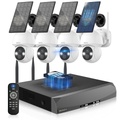Compatibility of Surveillance Cameras for Video Conferencing Software
The versatility of surveillance cameras has led to questions about their usability for video conferencing purposes, especially considering their relatively lower price compared to dedicated video conferencing cameras. To address this inquiry, it's crucial to delve into the technical principles of cameras. Regardless of whether a camera is designed for surveillance or video conferencing, they both capture data through their lenses. These captured data signals are initially analog. The primary distinctions between surveillance and video conferencing cameras lie in their lenses and output interfaces.
**Lenses and Pixel Differences:**
Surveillance cameras often feature lower pixel lenses compared to their video conferencing counterparts. Video conferencing cameras require higher image quality, and as a result, they come with higher pixel lenses. This difference in lens quality is one of the factors contributing to the disparity in price. While surveillance cameras are available at a few hundred dollars, dedicated video conferencing cameras usually start at around $2000.
**Output Interface Distinctions:**
Video conferencing cameras have two main output interfaces: USB and AV. USB outputs a digital signal, while AV outputs an analog signal. In the case of AV outputs, if your video conferencing camera uses an AV interface and you intend to use it with video conferencing software, you'll need to invest in a capture card. This card converts the analog signal from the AV interface into a digital one. On the other hand, USB-based video conferencing cameras can be directly connected and used with video conferencing software.
**Interfaces of Surveillance Cameras:**
Surveillance cameras offer two primary output interfaces: BNC and Ethernet (network cable). BNC interfaces provide analog signals that can be directly connected to surveillance capture cards for video data collection. Cameras with Ethernet interfaces transmit data signals through the network.
Having understood the technical principles and differences between surveillance and video conferencing cameras, let's address whether surveillance cameras can be used with video conferencing software.
**BNC Interface and AV Interface Compatibility:**
If a surveillance camera features a BNC interface, it can indeed be used with video conferencing software. This is achievable by using a BNC-to-AV adapter, which converts the BNC output to an AV interface. Once the conversion is done, connecting the camera through a video capture card enables its use within a video conferencing system.
**Ethernet Interface Limitations:**
Surveillance cameras with Ethernet interfaces usually employ proprietary protocols for data transmission. Due to this customization, cameras with Ethernet interfaces are generally not suitable for video conferencing systems.
In summary, cameras equipped with BNC interfaces and video conferencing cameras with AV interfaces are somewhat compatible. They can be interchanged using appropriate adapters. However, considering the nuanced requirements of video conferencing, such as pan-tilt-zoom (PTZ) functionalities, it's advisable to use dedicated video conferencing cameras to ensure optimal performance.
To conclude, while some interchangeability exists between surveillance and video conferencing cameras, dedicated video conferencing cameras are recommended for video conferencing systems due to their tailored features and functionalities. A **home video surveillance system** can be an excellent investment for security needs, while a dedicated **wifi security camera system** caters to specialized video conferencing requirements. The market offers a variety of options, including **8-channel wireless security camera systems** and **wireless home security camera systems** with versatile applications. Brands like OHWOAI provide top-notch solutions, ensuring that the right camera is selected for the intended purpose.
Sample Block Quote
Nam tempus turpis at metus scelerisque placerat nulla deumantos sollicitudin delos felis. Pellentesque diam dolor an elementum et lobortis at mollis ut risus. Curabitur semper sagittis mino de condimentum.









